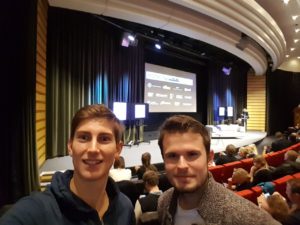Trello is one of my favorite online project management tools. I use it for my daily tasks, organizing school projects and at work. SUP46, Start-up people of Sweden, hosted an event in Stockholm were Justin Gallagher, VP of Product, shared Trello’s success story, tricks, and tips for Trello users and various user stories.

But what is Trello exactly?
Trello describes their application as an easy, free, flexible, and visual way to manage projects and organize anything, trusted by millions of people from all over the world.
Originally, Trello was developed at Fog Creek Software. Fog Creek has developed applications like FogBugz, Stack Overflow, and Glitch. At Fog Creek, there are regular Creek Weeks, where the people at the company explore potential products for the future. A prototype of Trello was created to solve high-level planning issues inspired by Kanban, Scrum and multiple numbers of sticky notes. In January 2011 the idea was pitched. Shortly later, a full-time development of the application began.
In the summer of 2012, Trello had reached 500.000 members and launched the Trello Android app. In July 2014, Trello became Trello, Inc., and spins off from Fog Creek. At that period Trello had over 4.75 million users. In May 2015, Trello decided to go international for Brazil, Germany, and Spain by offering Trello in multiple languages. In early 2017, Trello was acquired by Atlassian and today, Trello has more than 25 million users all over the world. Trello’s today’s goal is to create value for 100 million of users.
Justin made a point on what the Trello team had learned over these six past years. What makes teams successful in achieving its goal?
The first thing Justin mentioned is that the key to team success is empathy. It is important for a company like Trello to be effective working in teams where their goal is to create an efficient project management tool for individuals and teams. He pointed out a Google research, Project Aristotle, that gathered several of Google’s best and brightest to help the organization codify the secrets to team effectiveness. Google assumed that if they gathered the best people in the field, it would sum up to create the perfect team. Google’s people analytics manager, Julia Rozovsky, then stated: “We were dead wrong.”
Google’s result in Project Aristotle supports Justin’s statement on team success. Google found a research by psychologists and sociologist that focused on the term that is known as “group norms.” When teams gather there are these unwritten rules that make teams function as they do. These standards are the team’s traditions and behavior when they work together. These group norms can be openly acknowledged or unspoken by the team.
As described in this article in The New York Times, it wasn’t until Google started considering some intangibles that things began to fall into place. The results of these team norms are often robust. The teams at Trello spend a good time creating those team norms and empathy.
The second thing Justin talked about is how important communications are. Today, most of Trello’s employees work remotely. In the beginning, all the staff worked at the same place, in their central office in New York. But then one employee wanted to move to be closer to his family. The Trello team did not want to lose this employee, so they started to test the option to work remotely. More people joined the team remotely. Part of the company was therefore located in New York while other members were all over the world. Having productive meetings were half of the people are in a conference room and the other half is on a video call is not an easy thing to maintain. Trello, therefore, decided that all of their communications should be remote. Although three members of a planned meeting are at the office, they all attend the meeting remotely. When Trello is hiring new people, they do it remotely to test how people function in a remote working environment. But still, the primary challenge in this remote communication is that not all connections are equal due to a different technology.
Lastly, Justin talked about that collaboration tools are a social place. They create social value for the teams and active workplace environment. Dogfooding is also a phrase that Trello uses. “Eating your own dog food” or “dogfooding” means that developers use their software that they develop to work out bugs and generate new solutions. Trello uses, therefore, their application for their project management to create Trello. It is easier to see the flaws and how they would create better value for their users by using it as their management tool. Examples of other tools that Trello uses are for example Strive for the chat, appear.in for video calls and zoom for larger group calls.
In the end, Justin explained that there is no correct way to use Trello. The goal is to have it simple and easy to learn. The user should use the application to customize a personal Trello board and use in whatever way he or she wants.
There are a million ways to use Trello. If you have not already tried Trello, I recommend you check it out!
– Thorhildur Thorleiksdottir
Liked it? Why not to share then?












